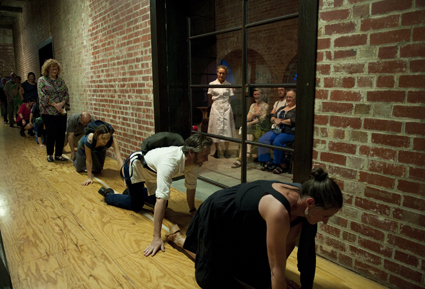For those game to wait
Jessica Sabatini: Born in a Taxi, The Waiting Room

Waiting Room, Born in a Taxi
photo Paul Dunn
Waiting Room, Born in a Taxi
Strange things can happen while we’re waiting, beneath the spell of the cosmic joke, as Beckett showed us 60 years ago with Waiting for Godot. In the Waiting Room, Born in a Taxi’s reworking of their 2008 show, we are made to wait again in amusement and confusion, and for what, we don’t know.
The colossal Newport Substation, with its elaborate stairs and passageways, allows for plenty of play and delay from the moment of arrival. We all meet in the foyer and are issued a ‘waiting room’ number; the group is then split into three and ushered by separate routes—via devious detours—to the site of performance: a small room upstairs in the building’s rear. There is no defined performance space, only rows of chairs where we sit and watch the performers enter to sit in our midst one by one. We stare at them, and at each other. They stare at us. Until this air of addled anticipation gives rise to mischief of another kind.
In many ways, The Waiting Room is a study in the subtlety of non-verbal cues. The performers don’t speak, but compete and cavort with each other, trying to persuade us by gesture to physically join in the game. They play a forceful version of musical chairs, for example, but some of us are more willing than others to give up our seats. To what extent will we participate, or resist?
As audience, we rely on the custom of being led by our performers. We don’t hope to usurp them, perhaps only to join them at times. That’s why invitations to participate must be clear. The tricky, commendably radical, but not quite successful aspect of The Waiting Room is that the performers suggest an abandonment of traditional roles—a chance to get swept up in dancing, music, conga lines and the like—but there are no clear invitations. It is rather an experiment in generating atmosphere, and with a few exceptions (perhaps these people attended the previous show?) we remain suspended, disoriented and waiting for stronger cues.
Is this deliberate discomfort? The hint is there in a gentle, jocular way. As with Godot, the absence of narrative gives rise to malaise, which becomes the fuel for play and fanciful tangents. And as with Godot, social neurosis is exposed: hierarchy-complexes, tendencies toward calculation and competition, our reliance on permission and authority (be it God, Godot, the law or Big Brother). From time to time, a voice from the speakers prompts us, at one point inviting responses to major life questions: “If you’ve ever experienced the death of someone you love, lie down on the ground…If you are a critic or judgmental person, stand in the corner,” and so on.
This painful and playful candour does not divide us in the end, but rather unifies us through physical games, which shows that something is working well here. However chaotic The Waiting Room sometimes feels, its treatment of life’s anxieties is no mere abstraction to ponder at home. It is an immediate experience, set lightheartedly in a communal context: a limited window of time spent in transparent, bonhomous social unease.
Born in a Taxi, The Waiting Room, performers Penny Baron, Carolyn Hanna, Kate Hunter, Andrew Gray, Deborah Batton, Nick Papas; The Substation, Melbourne, 28 Nov-1 Dec, 2013
RealTime issue #119 Feb-March 2014 pg. 39






